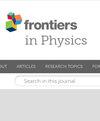粒子结构光散射的广义洛伦兹-米理论和模拟软件
IF 1.9
3区 物理与天体物理
Q2 PHYSICS, MULTIDISCIPLINARY
引用次数: 0
摘要
结构光是指具有调制相位和振幅的光场,其特点是具有明显的空间模式。它可应用于光学操纵、三维成像、遥感和通信等领域。广义洛伦兹-米氏理论(GLMT)扩展了基础米氏理论,以适应复杂的结构光,从而能够精确描述结构光与粒子之间的相互作用。GLMT 已成为分析球形粒子与任意结构光之间相互作用的核心理论框架。本文介绍了利用 GLMT 对结构光-球形粒子相互作用进行建模的模拟软件 ABSphere。然后全面回顾了具有代表性的结构光,包括 Laguerre-Gaussian、Bessel 和 Airy 光束,阐明了它们与球形粒子的相互作用。了解结构光的散射行为对于阐明其与球形粒子的潜在相互作用机制至关重要。本文还强调了粒子结构光散射建模的重要性,并讨论了 ABSphere 软件的未来发展方向。通过不断的理论完善和进步,可以加深对结构光与粒子相互作用机制的理解,从而实现光学应用和技术的创新。本文章由计算机程序翻译,如有差异,请以英文原文为准。
Generalized Lorenz-Mie theory and simulation software for structured light scattering by particles
Structured light refers to an optical field with modulated phase and amplitude, characterized by distinct spatial patterns. It has applications in optical manipulation, 3D imaging, remote sensing, and communications. The Generalized Lorenz-Mie Theory (GLMT) extends foundational Mie theory to accommodate complex structured lights, enabling precise characterization of structured light-particle interactions. GLMT has emerged as a central theoretical framework for analyzing interactions between spherical particles and arbitrary structured light. This paper introduces ABSphere, simulation software utilizing GLMT to model structured light-spherical particle interactions. It then comprehensively reviews representative structured lights, including Laguerre–Gaussian, Bessel, and Airy beams, elucidating their interactions with spherical particles. Understanding structured light scattering behavior is crucial for elucidating underlying interaction mechanisms with spherical particles. The paper also emphasizes the significance of modeling structured light scattering by particles and discusses future directions for ABSphere software. Through continuous theoretical refinements and advancements, deeper understanding of structured light-particle interaction mechanisms can be achieved, enabling innovations in optical applications and technologies.
求助全文
通过发布文献求助,成功后即可免费获取论文全文。
去求助
来源期刊

Frontiers in Physics
Mathematics-Mathematical Physics
CiteScore
4.50
自引率
6.50%
发文量
1215
审稿时长
12 weeks
期刊介绍:
Frontiers in Physics publishes rigorously peer-reviewed research across the entire field, from experimental, to computational and theoretical physics. This multidisciplinary open-access journal is at the forefront of disseminating and communicating scientific knowledge and impactful discoveries to researchers, academics, engineers and the public worldwide.
 求助内容:
求助内容: 应助结果提醒方式:
应助结果提醒方式:


